A PHOTO ESSAY BY George Bergson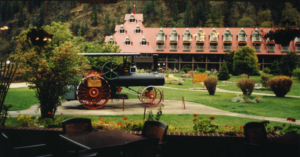
The Three Valley development goes back to the late 1950’s when Gordon and Ethel Bell bought some swampland in an isolated area off the Trans Canada Highway, 19 km west of Revelstoke in the Eagle Pass.
In 1960, after years of work and many truckloads of fill, they opened a seven-room motel. Fast-forward to 2008, and the motel has grown into a 200-room hotel with great family amenities, a helicopter pad and its very own ghost town.
When Gordon was 16 and working on a construction site, he discovered the remains of French Creek, a one time mining town north of Revelstoke. Even at that age, he took note of many historic artefacts abandoned and left to rust. After opening the motel with his wife, he went to work salvaging and restoring the old equipment.
That was the beginning of what has turned out to be one of B.C.’s history conservation efforts: Three Valley Gap Heritage Ghost Town.
On April 19th, 2004, my wife and I drove from our home in Penticton, BC, north and then east to Revelstoke, BC. Our primary purpose was to visit the Three Valley Gap Ghost Town and Railroad Museum.
We left Penticton early enough for the 260 km trip to allow a leisurely drive and to photograph as many railroad operations along the route as possible.
We stopped at Sicamous for coffee. We then drove to the CP yard, to photograph the CP modular building and the swing bridge on the CP main over the channel connecting Mara Lake to Shuswap Lake. This is a summer haven for boaters and tourists alike but the weather had not brought out any action on the two lakes from our vantage point.
Back onto the Trans-Canada Highway we proceeded east towards Revelstoke. At Craigellachie we were surprised to find Great Canadian Railtour Company’s eastbound “Rocky Mountaineer” parked on the CP main right at the replacement “station” and caboose on display. No passengers were on the ground although at every vestibule there were people enjoying the ambiance of the spring mountain air.
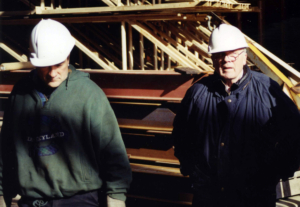 Son George Bell and Gordon Bell
Son George Bell and Gordon Bell
After we were back onto the highway, we observed several eastbound trains parked on the main as we drove on. When we got to Revelstoke, the reason was clear. The rail grinding Harsco Track Technologies RMS & Rail Grinding Train was tying up on a passing track right in town by the Revelstoke Railway Museum. A CP Rail Hyrail Truck with a tank was dousing small spot fires and followed the rail grinding train into the siding. We then went for lunch and during this time many trains passed through Revelstoke including “Rocky.” After lunch we snooped through CP’s yard in town and photographed every plow, spreader and caboose on the storage track.
Driving back west to the Three Valley Gap resort, some 19 km, we checked in at about 14:00. From our room looking west down the lake, the manicured gardens are nestled in a “U” formation in the middle of the resort. Our attention was drawn to a CASE steam tractor on display in the gardens. To our amazement there were three senior type people putting wood into the firebox. We went to the gardens and as smoke rose from the stack, valves were tinkered with and soon steam was coming up. Enough even to make the steam whistle moan throughout the valley. The CASE tractor crew started whistling at every east and westbound train passing but the big GE AC4400CW locomotives did not respond. The CP main is right behind (north of) the Chateau.
Then we went to the new railway roundhouse building to try to find out when the roof section, just built, was to be raised into place. This roof section was built of steel over the winter of 2003-2004 on the ground. When raised into place it will be over the future turntable area. It was designed to anchor into the steel columns at the rear of the new railway museum building and to complement it. (These columns were 8×12 and 12×12. There were 24 pillars, weighing 50 to 60 pounds per linear post.) When completed, lights will ring the roof dome and should be quite a sight for motorists passing on the Trans-Canada Highway. Also completion of this section will allow crews to work year-round on the railway coaches, caboose and backshops. Snow pack levels are quite high here.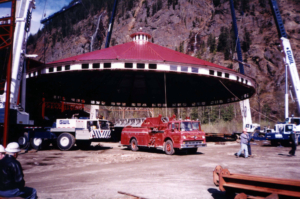 Four giant cranes from the GWIL firm were on site setting up, and a check with the loadmaster revealed that Tuesday morning, April 20th, the lift was to start at 8am. However, Mr. Bell, who engineered the whole project, pointed out that one crane would have to be re-rigged as the lifts must be positioned 90 degrees apart. This was not the case. Re-rigging took place on one crane at 8:15 and by 9am the set-up was done. The lift started at 9:30 and all four cranes lifted in unison. By 10am it was obvious that this 53.5 ton roof section was starting to move in the breeze slightly and appeared to resemble a flying saucer. Streamer ropes attached to the roof were then tied onto vehicles on site as anchors and the motion was soon controlled.
Four giant cranes from the GWIL firm were on site setting up, and a check with the loadmaster revealed that Tuesday morning, April 20th, the lift was to start at 8am. However, Mr. Bell, who engineered the whole project, pointed out that one crane would have to be re-rigged as the lifts must be positioned 90 degrees apart. This was not the case. Re-rigging took place on one crane at 8:15 and by 9am the set-up was done. The lift started at 9:30 and all four cranes lifted in unison. By 10am it was obvious that this 53.5 ton roof section was starting to move in the breeze slightly and appeared to resemble a flying saucer. Streamer ropes attached to the roof were then tied onto vehicles on site as anchors and the motion was soon controlled.
At 11:50 the roof section was raised the necessary 47 feet and was united with the steel columns of the museum building. At this point,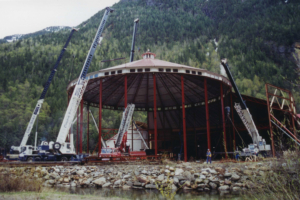 Gordon was on the roof of the museum building to receive and guide into place the new roof section. The alignment was perfect. The next step was to lift into place the remaining 24 “I” beams to support the roof section other than at the museum building proper. This task was completed by a local crane company who worked under the 53.5 ton roof section while the GWILL cranes maintained their lift. Finally by 15:30 the roof was lowered into place on the “I” beam columns. Welding the roof to the “I” beams was the next step while the GWIL cranes prepared to depart from their two-day task.
Gordon was on the roof of the museum building to receive and guide into place the new roof section. The alignment was perfect. The next step was to lift into place the remaining 24 “I” beams to support the roof section other than at the museum building proper. This task was completed by a local crane company who worked under the 53.5 ton roof section while the GWILL cranes maintained their lift. Finally by 15:30 the roof was lowered into place on the “I” beam columns. Welding the roof to the “I” beams was the next step while the GWIL cranes prepared to depart from their two-day task.
Now with the roof and “I” beams in place, steel siding will be attached to the “I” beams to complete the enclosure of the new turntable area. Photographs taken through the columns of coaches and caboose in their stalls will never be available again from the exterior.
On the positive side, work can continue on restoring the museum exhibits year-round. For example, already CN 58913 crew diner, ex CN dining car 1296, is undergoing reworking to resemble what a dining car interior would have looked like at the time. Already the interior roof section is taking shape and the new windows are in. This exhibit will be wheelchair accessible and judging from what can be seen, this on-going project will be something to enjoy when completed.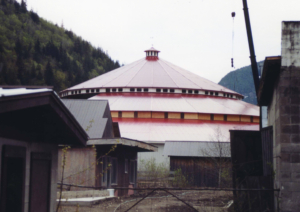
It was time to depart Three Valley Gap and head back to Penticton. I want to return when the turntable is installed at Canada’s newest roundhouse. As a young boy I watched in awe while steam locomotives were moved onto and through the turntable at CN’s Calder shops in Edmonton, Alberta in the early 1950’s.
George Bergson is a retired CNR electrician. He is an accomplished photographer and historian for CN Special Interest groups in the Okanagan and the Northwest. He is a regular contributor to this page.
